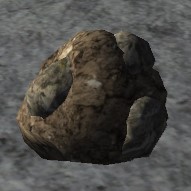Difference between revisions of "Unidentified fragment"
Jump to navigation
Jump to search
m (No unidentified brick fragment) |
m |
||
| Line 26: | Line 26: | ||
* Unidentified container fragment | * Unidentified container fragment | ||
* Unidentified statue fragment | * Unidentified statue fragment | ||
| − | * Unidentified | + | * Unidentified armour fragment |
At higher skill levels you may investigate an item of a specific type directly, e.g. an ore fragment or wooden fragment, at any point on the identification spectrum. | At higher skill levels you may investigate an item of a specific type directly, e.g. an ore fragment or wooden fragment, at any point on the identification spectrum. | ||
Revision as of 15:53, 7 April 2021
Main / Resources / Unidentified fragment
| Creation |
|---|
| Result |
|
| Skill and improvement |
|
Description
A fragment of another item. You think you can see how multiples of these fragments may fit together in a way that restores the original item. A [metal brush/chisel] would be useful to clear away some dirt and rock from it.
Unidentified fragments are found by investigating a tile.
Notes
- Unidentified fragments can be identified by using a stone chisel and/or a metal brush. Activate the tool, right click on the unidentified fragment and select Identify.
- The IDENTIFY action can be bound to a key.
- Once identified, the fragment will state how many other fragments need to be combined in order to create a finished product.
- This uses the Restoration skill.
Variants
Either upon investigation, or during the restoration process, you may encounter one of the following types of partially identified fragments.
- Unidentified wooden fragment
- Unidentified weapon fragment
- Unidentified tool fragment
- Unidentified metal fragment
- Unidentified container fragment
- Unidentified statue fragment
- Unidentified armour fragment
At higher skill levels you may investigate an item of a specific type directly, e.g. an ore fragment or wooden fragment, at any point on the identification spectrum.
